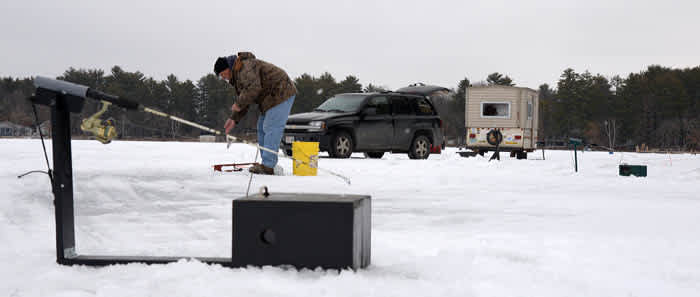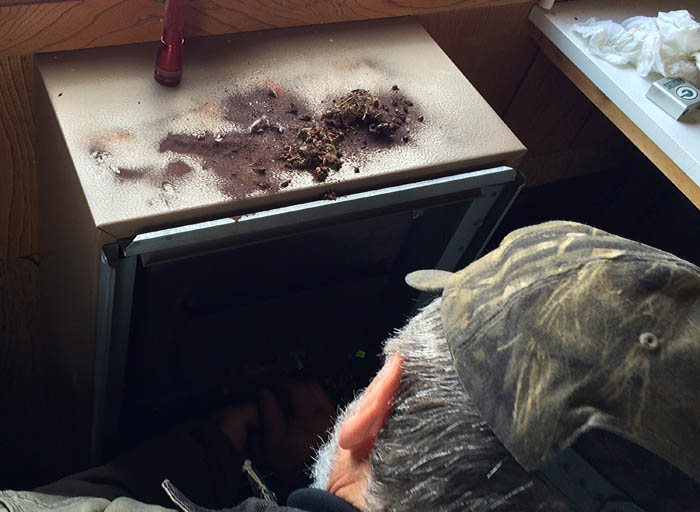In Search of Trout and a Functioning Furnace on Wisconsin Ice
Patrick Durkin 02.05.15

Mark Stange and I took turns wiping condensation off the ice shanty’s windows on a recent Sunday morning, doing what we could to keep an eye on our two tip-ups and four homemade hook-setting rigs on the Waupaca Chain of Lakes here in Wisconsin.
After each window wipe, we’d shake the water off our gloves, upper sleeves, and anything else we pressed into service. Although he’s not always the most empathetic guy, Stange apologized for not bringing rags, napkins, or paper towels to wipe the windows. Then again, at the rate we were wiping, we would have filled a barrel with soggy paper before noon.
Besides, Stange and his longtime fishing partner, Dan Wanty, had bigger problems on their minds. The shanty’s furnace refused to work, and they didn’t like using the stove’s propane burners to heat the place. They discussed the furnace’s potential problems, addressed the possibilities they could address, and when those efforts failed, they considered other options.
Finally, Wanty grabbed his cell phone and called their friend Barth “Boris” Allen at Billie’s Inc., a heating and air-conditioning contractor. Twenty minutes later, Wanty left the shanty, climbed into his truck and drove to the Columbia Lake boat landing to retrieve Allen and his toolbox.
“Now that’s service, and on a Sunday morning, no less,” I said as Stange and Wanty ushered Allen into the shanty. Allen soon had the little furnace apart and launched an archaeological dig that revealed a mound of rusty dust and the skeletal remains of bees, flies, ladybugs, and prehistoric creepy-crawlies. No wonder the propane couldn’t get through.
The furnace’s burners were throwing heat 30 minutes later. After studying the flames, Allen advised his friends to bring the shanty to his shop in spring for a more thorough cleaning.
With that distraction behind us, we had to confront the growing possibility that we’d finish the morning without catching one of the Chain’s fabled brown trout. Stange and I hadn’t chased these trout together since landing a seven-pounder during our first row-trolling get-together in May 2008.
While riding to the Chain this time, Stange hoped my return might bring some luck to what’s been a tough winter for trout fishing. He said none of his friends caught a trout the day before, and they hoped things would pick up around midmorning as light snow gave way to clearer skies and a rising barometer.
We saw Wanty cutting holes and setting lines in front of his truck’s headlights as we arrived in the dawn’s gray-light. After stopping near the shanty, Stange got out, fired up his ice auger and directed me to clear the holes with an ice skimmer as he finished drilling them.
We then teamed up to set our lines, rigging the tip-ups and hook-set rigs with a small split-shot sinker and three-inch shiners, and then suspending them about a foot off bottom. We were fishing a drop-off a few yards from the lake’s southern shoreline. The hole nearest land sat over 11 feet of water, while the farthest hole about 20 yards away was in 25 feet of water.

I was impressed with Stange’s homemade fishing rigs, which hold a stubby ice-fishing rod parallel to the ice. The rod’s butt rests in a pivoting holder that’s hooked to a bungee cord, and kept under tension by a thick wire halfway up the rod. After adjusting the wire for a hair-trigger release, Stange looped the fishing line lightly around the wire so a biting fish would pull the wire loose. In turn, that sets the hook as the bungee jerks the rod tip skyward.
We had our first strike within 10 minutes of finishing the setup, and raced out the door to the nearest tip-up. Stange hovered over the hole, staring at the tip-up for signs of a fish. The reel handle atop the tip-up’s crank-shaft sat still, however, so he lifted the tip-up from its hole, felt the empty line, and pulled it up to check its bait.
About 20 minutes later, the flag on the far tip-up sprung skyward, and then yawed back and forth as we hustled toward the hole. The reel-handle atop the crank-shaft spun into a blur as I tugged the rig from the hole and squeezed the line, pinching it to stop the fish’s run.
“Any size to it?” Wanty asked as I pulled in the line hand over hand, doing my best to keep it taut while pulling evenly.
“I don’t think so,” I replied. “It’s coming in easy.”
Sure enough, a few seconds later I pulled a 20-inch northern pike from the hole.
“Hammer-handle,” Stange said dismissively as I unhooked the sublegal fish and slipped it back down the hole.
Minutes later as we returned to the shanty, Stange noticed the nearest rod pointing downward but lifeless. He lifted the rod gently from its holder, reeled slowly to remove the slack, and then set the hook. “Fish on,” he announced as he reeled in line.

A fish was soon flopping atop the ice.
“Another hammer-handle,” Stange announced, and guided the slender pike back down the hole after removing the hook.
Meanwhile, the morning began slipping away. Just as we started losing hope that we’d get another strike on one of Stange’s homemade rigs, the nearest rod jerked down, sending us out the door once more.
The rod bounced hard once, twice, and thrice, but then fell limp when its line broke at the water line. Had it been cut by sharp ice or had the reel’s drag malfunctioned and put too much stress on the line?
None of us could say for certain. All we knew was that we still had a half-hour to fish before we left at noon for other obligations. And so we returned to our seats in the shanty, and resumed wiping condensation from its windows.
It wasn’t our day to catch a trout, but we agreed it would be fun to try again before the season closes.

